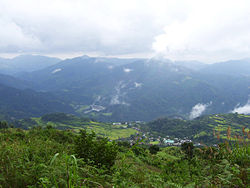This article needs additional citations for verification .(January 2014) |
Lubuagan | |
|---|---|
| Municipality of Lubuagan | |
 Lubuagan from the Magmag-an Pass | |
 Map of Kalinga with Lubuagan highlighted | |
 Interactive map of Lubuagan | |
Location within the Philippines | |
| Coordinates: 17°21′N121°11′E / 17.35°N 121.18°E | |
| Country | Philippines |
| Region | Cordillera Administrative Region |
| Province | Kalinga |
| District | Lone district |
| Founded | 1905 |
| Barangays | 9 (see Barangays) |
| Government | |
| • Type | Sangguniang Bayan |
| • Mayor | Joel B. Tagaotao |
| • Vice Mayor | Alonzo C. Saclag Jr. |
| • Representative | Allen Jesse C. Mangaoang |
| • Municipal Council | Members |
| • Electorate | 9,890 voters (2025) |
| Area | |
• Total | 234.20 km2 (90.43 sq mi) |
| Elevation | 820 m (2,690 ft) |
| Highest elevation | 1,880 m (6,170 ft) |
| Lowest elevation | 348 m (1,142 ft) |
| Population (2024 census) [3] | |
• Total | 8,660 |
| • Density | 37.0/km2 (95.8/sq mi) |
| • Households | 1,982 |
| Economy | |
| • Income class | 4th municipal income class |
| • Poverty incidence | 7.52 |
| • Revenue | ₱ 144 million (2022) |
| • Assets | ₱ 362.7 million (2022) |
| • Expenditure | ₱ 89.35 million (2022) |
| • Liabilities | ₱ 292.7 million (2022) |
| Service provider | |
| • Electricity | Kalinga - Apayao Electric Cooperative (KAELCO) |
| Time zone | UTC+8 (PST) |
| ZIP code | 3802 |
| PSGC | |
| IDD : area code | +63 (0)74 |
| Native languages | Ilocano Tagalog |
| Website | www |
Lubuagan, officially the Municipality of Lubuagan (Ilocano : Munisipio ti Lubuagan, Filipino : Bayan ng Lubuagan), is a municipality in the province of Kalinga, Philippines. According to the 2024 census, it has a population of 8,660 people. [5]
Contents
- History
- Geography
- Barangays
- Climate
- Demographics
- Economy
- Government
- Local government
- Elected officials
- Tourism
- Culture
- Education
- Primary and elementary schools
- Secondary schools
- Notable personalities
- References
- External links
The municipality served as the seat of the National Government from March 6 to May 17, 1900, during the time of Gen. Emilio Aguinaldo. It is located at 800 metres (2,600 ft) above sea level in the southern part of Kalinga and in the heart of the Cordillera. It has a land area of 23,420 hectares (57,900 acres).


